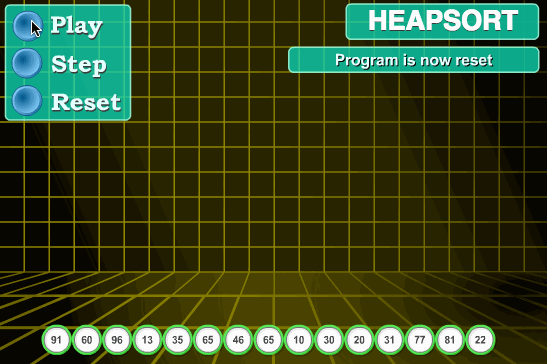Heap sorting is a sort algorithm designed by using the data structure of heap. Stack is a structure of nearly complete binary tree, which satisfies the properties of stack at the same time: the key value or index total number of the child node is less than (or greater than) its parent node.
- Algorithm description
- The initial sequence to be sorted is constructed into a large top heap, which is the initial disordered area;
- Exchange the top element R[1] with the last element R [n], and a new unordered region (R1,R2,...) is obtained Rn-1) and a new ordered region (Rn), which satisfy R[1,2 N-1]<=R[n];
- Since the new top of the heap may violate the nature of the heap after exchange, the current unordered area (R1,R2,...) needs to be changed Rn-1) is adjusted to a new heap, and then R[1] is adjusted again
By exchanging with the last element of the disordered region, a new disordered region (R1,R2 Rn-2) and a new ordered region (Rn-1,Rn). Repeat this process until the number of elements in the ordered area is n-1, then the whole sorting process is completed.

- Code implementation: the complete binary tree has a feature: the left child node position = twice the current parent node + 1, the right child node position = twice the current parent node + 2.
- Code implementation:
public class DuiPaiXu2 {
private static void daDingDui(int[] arrays, int start, int end) {
// Parent node
int curr = start;
// Left and right nodes
int left = curr * 2 + 1;
// int right = curr * 2 + 2;
// Father's day value
int temp = arrays[curr];
for (; left < end; curr = left, left = curr * 2 + 1) {// Change its left child node into a parent node, and get the left child node according to its transformed parent node
if (left < end && arrays[left] < arrays[left + 1]) {// Determine which child node is the largest
left++;// Change to the right child node as the parent node,
}
if (arrays[left] > temp) {// Determine the maximum value of the left and right child nodes and the value of the current parent node
arrays[curr] = arrays[left];
arrays[left] = temp;
}
}
}
private static void jiaoHuan(int[] arrays, int index1, int index2) {
int temp = arrays[index1];
arrays[index1] = arrays[index2];
arrays[index2] = temp;
}
private static void duiPaiXu(int[] arrays) {
int length = arrays.length;
int left;
// Traverse from (n/2-1) -- > 0 to gradually generate a large top heap for the sequence to be sorted
for (left = length / 2 - 1; left > 0; left--) {
daDingDui(arrays, left, length - 1);
}
// Adjust the sequence from the last element, and continuously narrow the adjustment range until it contains only the first element
for (left = length - 1; left > 0; left--) {
//After exchanging the first and left child node elements, the left child node is the largest element in the sequence.
jiaoHuan(arrays, 0, left);
// Adjust the remaining heap sequence to ensure that the right child node is the maximum value in the remaining heap sequence
daDingDui(arrays, 0, left - 1);
}
}
public static void main(String[] args) {
int arrays[] = { 20, 30, 90, 40, 70, 110, 60, 10, 100, 50, 80 };
System.out.println(Arrays.toString(arrays));
duiPaiXu(arrays);
System.out.println(Arrays.toString(arrays));
}
}